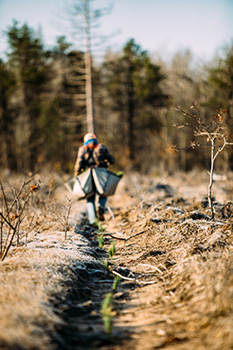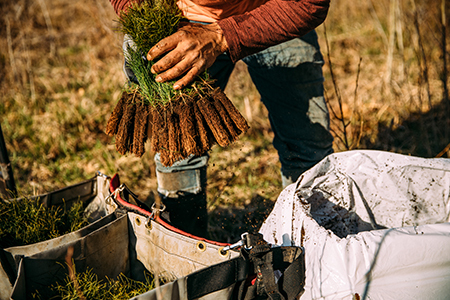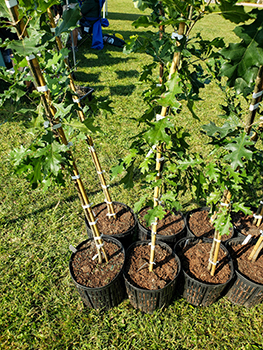There’s no better time to plant a tree than in Michigan’s spring
By KATHLEEN LAVEY
Communications representative, Forest Resources Division
Michigan Department of Natural Resources
On a crisp, bright Saturday in early April at Detroit’s Rouge Park, a small army of volunteers were ready to work.
Shovels? Check!
Strong arms? Check!
Trees ready to go into the ground? Check and check again.
Staci Reed and other members of Alpha Kappa Alpha sorority were among those volunteers, planting cherry trees to establish an urban orchard at the popular 1,184-acre city park, which also includes walking trails, recreation areas and pools.
“We’re here to help make the city of Detroit more green and more beautiful than it already is,” Reed said, shovel in hand.

Planting a tree can create a lasting and lovely effect on the environment, with many benefits including cleaner water and air. And the early spring months of April and May are prime times for tree planting.
Michigan celebrates Arbor Day on April 26, and Gov. Gretchen Whitmer has declared the week of April 21-27 as Arbor Week.
The Michigan Department of Natural Resources has pledged to lead Michiganders in planting more than 50 million trees by 2030 through the Mi Trees program.
That effort is already well under way, with 17 million trees planted by the DNR in state forests since 2021. An additional 112,000 trees have been planted by volunteers in other public and private landscapes like yards, fields, parks and school grounds across the state.
“We want to help everybody think about getting out there and planting trees,” said Kevin Sayers, urban and community forestry program coordinator for the DNR. “A well-placed tree or trees can beautify the neighborhood or the landscape, cool your home in summer and help clean air and water.”
Choose your tree and location
Planting a tree this spring will benefit you today – and others in the future – if you choose your tree and your location carefully and provide basic care as your tree grows.
|

If you live in the city, you might want to stay away from planting maples, for example. They’re beautiful trees, grow well and provide fall color. But many Michigan cities already have a lot of maples on city streets and in parks.
“We want to try to get a good variety of trees out there so that if something comes along like Dutch elm disease or the emerald ash borer, we won’t see treeless streets,” said Lawrence Sobson, urban and community forester with the DNR.
Dutch elm disease wiped out stately elms lining many Michigan streets starting in the 1950s, and the ash borer, an invasive insect, has destroyed millions of ash trees over the past 20 years or so.
Also rethink your childhood memories of street trees.
You may remember growing up with ash, silver maple or Bradford pears, but those once-popular trees have been nudged out by others that work better or stay healthier in Michigan’s environment.
Experts advise planting a variety of trees that will provide benefits to you and your community, like native trees that help support wildlife, large shade trees that help cool your home in the summer and ornamental and fruit trees to beautify your landscape.
“I love black gum, also called black tupelo trees,” Sobson said. “Those are your maple replacements right there. They’re easy to maintain, they don’t get super wide, they’re readily available in a lot of different cultivars and they’re a really, really nice tree.”
For areas that are wet or flood, the hackberry is a good choice – it doesn’t mind having wet feet some of the time.
“It’s a good-sized tree that is usually not expensive to buy,” Sobson said.
|

Want cleaner air? A yellowwood could help.
“It’s a really good air filter tree,” Sobson said. “It has white flowers which are nice, wider branching and not super big.”
Another hardy native tree that’s good for urban landscapes is the Kentucky coffee tree.
“You can throw the kitchen sink at it and it will still live,” Sobson said. “It’s native to Michigan, it’s climate-adaptable and it’s slower-growing. In the winter it can look like the saddest little Charlie Brown tree, but it will come through.”
A good choice for small spaces is ironwood. The tree grows slowly and stays compact. However, it’s not always readily available in nurseries. Another smaller tree is serviceberry, also known as juneberry or sugar plum.
“It’s good for wet areas, it’s a utility-friendly tree, there are multi-stemmed varieties that aren’t going to get very big,” Sobson said.
Bonus: “The berries are tasty, and you can find these trees to buy anywhere,” he said.
Plant with care
The same thing people say is important in real estate – “location, location, location” – also is important for trees. You don’t want to plant a towering pine under a utility line, or a deep-rooted tree over your sewer lines.
“You don’t want to put in a tree and then have to take it out after a few years because you didn’t plan it well,” Sobson said.
Planting the tree you’ve chosen involves a lot more than just digging a hole the size of the pot and plopping the tree into it.
|

Before putting a shovel in the ground, call 811 by phone or visit missdig811.org online. Workers will mark the locations of underground water, gas and other utility lines so you don’t accidentally dig them up.
Then, dig the hole for your tree. Sorry to be the bearer of bad news, but it has to be big – make it two to three times the width of the root ball or container the tree is in. Don’t go too deep, though. Keep your hole about the depth of the container or root ball.
“It’s all about establishing a root system, and roots need space to spread out and get established,” Sobson said.
If your tree is in a container, remove the container and then carefully shave off the outer roots so that new roots can sprout from the fresh cuts. For a tree that is balled and wrapped in burlap, place the tree in the hole and then remove and dispose of at least the top half of the burlap and wire cage.
Plant trees at a depth that allows you to cover roots but still see the flare at the bottom of the trunk.
Once the tree is in the ground, water it well. Then come back and water regularly throughout the season. Water your new tree frequently and deeply the first year or two, especially if weather is hot and dry.
Water the entire area under the canopy of the tree, not just near the trunk. A layer of mulch will help protect tree roots, but don’t mound it up so that it looks like a volcano or let much touch the tree trunk. That can damage the tree. Fertilizer isn’t recommended for the first several years.
After you’ve put the shovel and the hose away, relax and enjoy watching your tree grow over time. And don’t forget to pin your new planting on the DNR’s interactive Mi Trees map.
“You’re planting something that both you and future generations can enjoy,” Sobson said.
Find out more about trees and Michigan’s forests.
|
Check out previous Showcasing the DNR stories in our archive at Michigan.gov/DNRStories. To subscribe to upcoming Showcasing articles, sign up for free email delivery at Michigan.gov/DNREmail.
Note to editors: Contact: John Pepin, Showcasing the DNR series editor, 906-226-1352. Accompanying photos and a text-only version of this story are available below for download. Caption information follows. Credit Michigan Department of Natural Resources, unless otherwise noted.
Text-only version of this story.
Arbor Day Foundation planting: Workers spread out across a field in the northern Lower Peninsula in 2022 to plant new trees on Michigan state forest land. (Photo courtesy: Arbor Day Foundation)
Shovel shot: A worker puts a tree into the ground on state forest land in the northern Upper Peninsula. (Photo courtesy: Arbor Day Foundation)
Tree plugs: A worker prepares to plant so-called “tree plugs,” including a seedling and a tube of soil to protect its roots. (Photo courtesy: Arbor Day Foundation)
Trees ready to go: Trees in containers await their new homes at a tree giveaway at the Michigan Department of Natural Resources’ Outdoor Adventure Center in Detroit.
Worker atmospheric: A worker makes his way up a row while planting trees on state forest land in 2022. (Photo courtesy: Arbor Day Foundation)
|